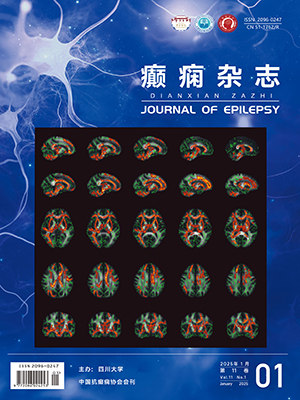| 1. |
常琳, 王小姗.中国癫痫流行病学调查研究进展.国际神经病学神经外科学杂志, 2012, 39(02): 161-164.
|
| 2. |
Nakken KO, Solaas MH, Kjeldsen MJ, et al. Which seizure-precipitating factors do patients with epilepsy most frequently report. Epilepsy Behav, 2005, 6(1): 85-89.
|
| 3. |
Sperling MR, Schilling CA, Glosser D, et al. Self-perception of seizure precipitants and their relation to anxiety level, depression, and health locus of control in epilepsy. Seizure, 2008, 17(4): 302-307.
|
| 4. |
Ferlisi M, Shorvon S. Seizure precipitants (triggering factors) in patients with epilepsy. Epilepsy Behav, 2014, 33(4): 101-105.
|
| 5. |
Novakova B, Harris PR, Ponnusamy A, et al. The role of stress as a trigger for epileptic seizures: a narrative review of evidence from human and animal studies. Epilepsia, 2013, 54(11): 1866-1876.
|
| 6. |
Kasteleijn-Nolst Trenite DG. Provoked and reflex seizures: surprising or common. Epilepsia, 2012, 53(Suppl 4): 105-113.
|
| 7. |
Shorvon SD. The causes of epilepsy: changing concepts of etiology of epilepsy over the past 150 years. Epilepsia, 2011, 52(6): 1033-1044.
|
| 8. |
Balamurugan E, Aggarwal M, Lamba A, et al. Perceived trigger factors of seizures in persons with epilepsy. Seizure, 2013, 22(9): 743-747.
|
| 9. |
Fang PC, Chen YJ, Lee IC. Seizure precipitants in children with intractable epilepsy. Brain Dev, 2008, 30(8): 527-532.
|
| 10. |
Spector S, Cull C, Goldstein LH. Seizure precipitants and perceived self-control of seizures in adults with poorly-controlled epilepsy. Epilepsy Res, 2000, 38(2-3): 207-216.
|
| 11. |
van Campen JS, Jansen FE, de Graan PN, et al. Early life stress in epilepsy: a seizure precipitant and risk factor for epileptogenesis. Epilepsy Behav, 2014, 38(10): 160-171.
|
| 12. |
Shumiloff NA, Lam WM, Manasco KB. Adrenocorticotropic hormone for the treatment of west syndrome in children. Ann Pharmacother, 2013, 47(5): 744-754.
|
| 13. |
Lotufo PA, Valiengo L, Bensenor IM, et al. A systematic review and meta-analysis of heart rate variability in epilepsy and antiepileptic drugs. Epilepsia, 2012, 53(2): 272-282.
|
| 14. |
Al-Biltagi MA. Childhood epilepsy and sleep. World J Clin Pediatr, 2014, 3(3): 45-53.
|
| 15. |
Giorgi FS, Guida M, Caciagli L, et al. What is the role for EEG after sleep deprivation in the diagnosis of epilepsy Issues, controversies, and future directions. Neurosci Biobehav Rev, 2014, 47(12): 533-548.
|
| 16. |
Del Felice A, Fiaschi A, Bongiovanni GL, et al. The sleep-deprived brain in normals and patients with juvenile myoclonic epilepsy: a perturbational approach to measuring cortical reactivity. Epilepsy Res, 2011, 96(1-2): 123-131.
|
| 17. |
Xu X, Brandenburg NA, Mc Dermott AM, et al. Sleep disturbances reported by refractory partial-onset epilepsy patients receiving polytherapy. Epilepsia, 2006, 47(7): 1176-1183.
|
| 18. |
Tellez-Zenteno JF, Matijevic S, Wiebe S. Somatic comorbidity of epilepsy in the general population in canada. Epilepsia, 2005, 46(12): 1955-1962.
|
| 19. |
Dittner AJ, Wessely SC, Brown RG. The assessment of fatigue: a practical guide for clinicians and researchers. J Psychosom Res, 2004, 56(2): 157-170.
|
| 20. |
Papadopoulos AS, Cleare AJ. Hypothalamic-pituitary-adrenal axis dysfunction in chronic fatigue syndrome. Nat Rev Endocrinol, 2012, 8(1): 22-32.
|
| 21. |
Tanaka S, Kuratsune H, Hidaka Y, et al. Autoantibodies against muscarinic cholinergic receptor in chronic fatigue syndrome. Int J Mol Med, 2003, 12(2): 225-230.
|
| 22. |
Gabr WM, Shams ME. Adherence to medication among outpatient adolescents with epilepsy. Saudi Pharm J, 2015, 23(1): 33-40.
|
| 23. |
Svalheim S, Sveberg L, Mochol M, et al. Interactions between antiepileptic drugs and hormones. Seizure, 2015, 28(Supple 189): 12-17.
|
| 24. |
Herzog AG. Catamenial epilepsy: definition, prevalence pathophysiology and treatment. Seizure, 2008, 17(2): 151-159.
|
| 25. |
Herzog AG. Catamenial epilepsy: Update on prevalence, pathophysiology and treatment from the findings of the NIH progesterone treatment trial. Seizure, 2015, 28(7): 18-25.
|
| 26. |
Asadi-Pooya AA, Ghaffari A. Do patients with epilepsy believe they need specific dietary restrictions. Epilepsy Behav, 2004, 5(6): 945-948.
|
| 27. |
Asadi-Pooya AA, Sperling MR. Do foods precipitate seizures A cross-cultural comparison. Epilepsy Behav, 2007, 11(3): 450-453.
|
| 28. |
Miwa H, Iijima M, Tanaka S, et al. Generalized convulsions after consuming a large amount of gingko nuts. Epilepsia, 2001, 42(2): 280-281.
|
| 29. |
Garg SK, Kumar N, Bhargava VK, et al. Effect of grapefruit juice on carbamazepine bioavailability in patients with epilepsy. Clin Pharmacol Ther, 1998, 64(3): 286-288.
|
| 30. |
Samokhvalov AV, Irving H, Mohapatra S, et al. Alcohol consumption, unprovoked seizures, and epilepsy: a systematic review and meta-analysis. Epilepsia, 2010, 51(7): 1177-1184.
|
| 31. |
Stanuszek A, Wnekowicz E, Kuzniar E, et al. Seizure-precipitating factors in relation to medical recommendations: Especially those limiting physical activity. J Child Neurol, 2015, 30 (12): 1569-1573.
|
| 32. |
Arida RM, de Almeida AC, Cavalheiro EA, et al. Experimental and clinical findings from physical exercise as complementary therapy for epilepsy. Epilepsy Behav, 2013, 26(3): 273-278.
|
| 33. |
Howard GM, Radloff M, Sevier TL. Epilepsy and sports participation. Curr Sports Med Rep, 2004, 3(1): 15-19.
|
| 34. |
Arida RM, Scorza FA, Terra VC, et al. Physical exercise in epilepsy: What kind of stressor is it. Epilepsy Behav, 2009, 16(3): 381-387.
|
| 35. |
Arida RM, Cavalheiro EA, da Silva AC, et al. Physical activity and epilepsy: proven and predicted benefits. Sports Med, 2008, 38(7): 607-615.
|
| 36. |
Guaranha MS, Garzon E, Buchpiguel CA, et al. Hyperventilation revisited: Physiological effects and efficacy on focal seizure activation in the era of video-EEG monitoring. Epilepsia, 2005, 46(1): 69-75.
|
| 37. |
Verrotti A, Trotta D, Salladini C, et al. Photosensitivity and epilepsy. J Child Neurol, 2004, 19(8): 571-578.
|




